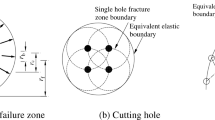Abstract
The blasting construction of Shuidun Tunnel, China (a thin bedrock roof tunnel) is the engineering background in this paper. The numerical simulation method is adopted and combined with the verification of field measurement. The longitudinal, circumferential and radial distribution of the surrounding rock near the tunnel face is analyzed. The effects of various physical mechanical parameters of overlying soft rock on surrounding rock vibration are also discussed. The results may provide reference for construction safety control of similar projects. The main conclusions are as follows: The maximum value of the significant coefficient of cavity effect appears in the range of 2–4 m behind the tunnel face. The data like vault settlement within this range should be monitored emphatically. In the circumferential direction, the closer to the tunnel wall, the more significant the circumferential characteristic of the vibration velocity vector of surrounding rock is, and the maximum vibration velocity appears at the contact point between the rock layer interface and the tunnel contour wall. In the radial direction, the peak vibration velocity of surrounding rock decreases rapidly in the range of 1 m, while the attenuation tends to be gradual in the range of 2–4 m. The peak vibration velocity of surrounding rock near the tunnel face is positively correlated with the bulk density and poisson’s ratio of overlying soft stratum, and negatively correlated with its elastic modulus and internal friction angle of overlying soft stratum.











Similar content being viewed by others
References
Barla G (2016) Full-face excavation of large tunnels in difficult conditions. J Rock Mech Geotech Eng 8(3):294–303
Chakraborty AK, Jethwa JL, Paithankar AG (1994) Effects of joint orientation and rock mass quality on tunnel blasting. Eng Geol 37(3/4):247–262
Deng E, Yang WC, Lei MF, Xiao Y (2017a) Research on the characteristics of surrounding rock vibration during the tunnel blasting construction with thin roof bedrock layer. J Railw Sci Eng 14(2):308–314 (in Chinese)
Deng E, Yang WC, Yin RS (2017b) Feature of influence area distribution of the surrounding rock vibration during the tunnel blasting with thin bedrock roof. J Railw Sci Eng 14(12):2651–2659 (in Chinese)
Deng E, Yang WC, Lei MF (2018) Instability mode analysis of surrounding rocks in tunnel blasting construction with thin bedrock roofs. Geotech Geol Eng 36(4):2565–2576
Dowding CH, Aimone CT (1985) Multiple blast-hole stresses and measured fragmentation. Rock Mech Rock Eng 18(1):17–36
Duan BF, Xia HL, Yang XX (2018) Impacts of bench blasting vibration on the stability of the surrounding rock masses of roadways. Tunn Undergr Space Technol 71:605–622
GB 6722-2014 (2014) Technical code for blasting safety. China Standards Press, Beijing (in Chinese)
GB/T 50218-2014 (2014) Standard for engineering classification of rock mass. China Standards Press, Beijing (in Chinese)
Panda MK, Mohanty S, Pingua BMP, Mishra AK (2014) Engineering geological and geotechnical investigations along the head race tunnel in Teesta Stage-III hydroelectric project. India Eng Geol 181:297–308
Shen YS, Zou CL, Jin ZZ (2015) A study of the dynamic response characteristics of a tunnel structure through an interface of soft and hard rock. Mod Tunn Technol 52(3):95–102 (in Chinese)
Song ZP, Li SH, Wang JB (2018) Determination of equivalent blasting load considering millisecond delay effect. Geomech Eng 15(2):745–754
Sun BP, Gao WX, Zhou SS (2018a) Study on numerical simulation and application of blasting of tunnel excavation. Trans Beijing Inst Technol 38(10):1025–1036 (in Chinese)
Sun KG, Xu WP, Qiu WG (2018b) Study on the characteristics of safety distribution changing with buried depth for metro station in upper-soft and lower hard stratum. Adv Civ Eng 2018:1–14
Tisen YM, Kuo MC, Juang CH (2006) An experimental investigation of the failure mechanism of simulated transversely isotropic rocks. Int J Rock Mech Min Sci 43(8):1163–1181
Wang MY, Qian QH (1995) Attenuation law of explosive wave propagation in cracks. Chin J Geotech Eng 17(2):42–46 (in Chinese)
Wang ZY, Fang C, Chen YL (2013) A comparative study of delay time identification by vibration energy analysis in millisecond blasting. Int J Rock Mech Min Sci 60:389–400
Xue XM, Wang J, Chen JQ (2015) Influence of structural planes of rock mass to the blasting stress wave. Metal Miner S1:36–39 (in Chinese)
Yang YL (2012) Hollow effect induce by blasting vibration in shallow tunnels. Blasting 29(3):127–130 (in Chinese)
Yang SQ, Chen M, Fang G (2018) Physical experiment and numerical modeling of tunnel excavation in slanted upper-soft and lower-hard strata. Tunn Undergr Space Technol 82:248–264
Yu J, Liu SY, Tong LY (2010) Hollow effect induced by blasting vibration in shallow tunnels. J Southeast Univ 40(1):176–179 (in Chinese)
Yunteng YIN, Tingchun LI (2013) Analysis and study of the seismic failure mechanism and aseismic measures of a tunnel structure in the rock–soil interface area. Mod Tunn Technol 50(4):84–91 (in Chinese)
Zhang JC, Cao XJ, Zheng SY (2005) Experimental study on vibration effects of ground due to shallow tunnel blasting. Rock Mech Rock Eng 24(22):4158–4163 (in Chinese)
Zhao J, Gong QM, Eisensten Z (2007) Tunnelling through a frequently changing and mixed ground: a case history in Singapore. Tunn Undergr Space Technol 22(4):388–400
Acknowledgements
The research reported in this paper was supported by the National Natural Science Foundation of China under Grant No. 51478474 and the Fundamental Research Funds for the Central University of Central South University under Grant No. 2019zzts291. The authors are grateful for the supports awarded.
Author information
Authors and Affiliations
Corresponding author
Additional information
Publisher's Note
Springer Nature remains neutral with regard to jurisdictional claims in published maps and institutional affiliations.
Rights and permissions
About this article
Cite this article
Deng, E., Yang, W. & Zhang, P. Analysis of Surrounding Rock Vibration and the Influence of Soft Rock Mechanical Parameters During the Tunnel Blasting with Thin Bedrock Roof. Geotech Geol Eng 38, 537–550 (2020). https://doi.org/10.1007/s10706-019-01044-3
Received:
Accepted:
Published:
Issue Date:
DOI: https://doi.org/10.1007/s10706-019-01044-3




